So, we’ve already had a look at how to get more bhp out of your car but there is another way to get it going faster without ever touching the engine. We’re talking, of course, about improving its handling.
Handling improvements might not be as glamorous as big power figures – and they won’t give you a handy number to quote to your mates down the pub (unless you’re talking lap times) – but they will make your car a hell of a lot more fun to drive. Improving your chassis can also increase your fuel economy, reduce tyre wear and even make your car safer to drive whilst you’re at it!
So what’s the best way to make your car handle like it’s on rails? Now that it flies off a shovel, how can you make sure it sticks to a blanket? Well, the first (and most obvious) thing to overhaul is the suspension, and there are three main levels of improvement you can go for. After you’ve fitted new suspension, it’s important that you also take into account the point that follows it in this list – wheel alignment. Unless you own an alignment rig(!), this isn’t something that you can do yourself at home, but luckily it is a service that we provide at our performance fitting centre in Wrexham – which houses a very nice Hunter four wheel alignment system.
Performance Suspension
The suspension your car came with from the factory represents a bit of a compromise by the manufacturer. The manufacturer will have tuned your cars suspension with lots of competing demands in mind. It must be safe, quiet, and comfortable. If it’s a sports model it also needs to handle well. For most drivers, these compromises are probably fine. For the performance driving enthusiast, aftermarket parts can retune the suspension in the direction of better handling.
Lowering springs


When it comes to making a car go round corners fast, its centre of gravity is of great importance. That’s why race cars have the engine mounted low and (ideally) towards the middle of the car. It’s also why short fat guys can run around corners quicker than tall thin ones can (it’s true, we just tested it here in the DT office!). If you just bust out the gas axe and try relocating your engine though, you’re likely to end up with a bit of a mess – so what can you, a mere mechanical mortal, do to lower your centre of gravity?
Lower the car is what! The cheapest (but not the simplest) way to do this is to fit a set of lowering springs. These fit in place of your original springs, and are quite simply shorter. If you lower your car by 30 mm, then congratulations; you’ve just lowered every last bit of sprung mass on the car by the same amount – something that will have a great effect on its centre of gravity (and make it look a lot better as a bonus). Lowering springs also tend to be stiffer – which will reduce body roll through the twisties, as well as compression during weight transfer (hard acceleration or braking). Many are also progressively wound (like in the picture above), which means that your suspension will be softer when you’re not giving it any, and firmer when you are. If your car features active suspension, you’ll probably also be pleased to know that by keeping the original dampers in place, lowering springs will often work in conjunction with these systems. Please contact us if you’d like further information about this.
In order to fit lowering springs to most cars, you’ll have to remove your original dampers and then remove the springs (on the front at least). Car suspension springs are powerful bits of kit – so be warned – this can be a potentially dangerous job if you don’t know what you’re doing and/or don’t have the right tools. Proper spring compressors are therefore a must if you do the job yourself – or you could just let our trained mechanics do the hard work for you! Another thing to watch out for is the fact that due to differences in windings, sometimes you won’t be able to see any difference in height between your old springs and the new lowered ones. Don’t despair – once they are on the car and have had chance to bed in, you will see a difference!
Sports Suspension Kit


The next step up from fitting lowering springs is to fit a complete replacement kit. The benefit here is that your dampers will be tuned to match your new springs. While most springs will work with your original dampers, these will probably be a little bit on the soft side, possibly leaving the car feeling bit underdamped and “busy” over some surfaces.
They’ll also probably wear out a bit quicker as the bouncier springs give them more of a workout. This is doubly true if the dampers are already a bit old when you fit the springs. Pairing a stiffer spring with an uprated damper will give a more controlled ride, particularly over bumpy surfaces. This is certainly the way we’d recommend you go if you’re going much below 30mm lowering.
Sports dampers may also come with adjustable damping, allowing you to select the exact level of sportiness you want. A high-quality pre-set damper is no bad thing though. Very clever engineers have dialled it in already, before you fit it.
Coilovers


The Godfathers of control and adjustability; coilovers are the badger’s nadgers. This type of suspension is height adjustable – meaning that you can slam your car into the weeds if you want to – and this makes coilovers ideal for use in stance projects. But this level of adjustability is also just what you need if you’re after the ultimate handling setup. You can use a process called corner-weighting to distribute weight around your car using the suspension’s ride height.
Because you’re doing away with the factory springs and dampers, the engineers developing these have been free to develop a paired spring and damper without worrying about it fitting. The units can be much thicker than the originals (provided they still fit) and the spring and damper can be much firmer than the original kit.
Like many things, you’ll find that you tend to get more adjustability with coilovers, the more you pay. Whilst basic units are only height adjustable, more advanced types also have adjustable stiffness. Suspension stiffness is split into ‘bump’ (compression) and ‘rebound’ (decompression) – with most variable stiffness units offering adjustable rebound, and more expensive ones, adjustable bump too.
We’ll be writing a full guide on suspension settings at some point in the future – but if you’re going to be having your suspension professionally set up, more adjustability is generally better.
What about electronic damping?

Once upon a time, having computer-controlled dampers on your car was a feature found on very fancy machinery like the Porsche 959. As time has gone by, it’s crept down until you can now spec it on a nice family hatch. While it is cool, it does complicate things a little bit when you come to modify your car.
Normally the system means different shock absorbers, but the same springs, so lowering springs are generally not a problem. We should note that if the car uses air-bags instead of springs on one axle, you’ll probably need a specific spring kit and the air suspension system modifying.
Fitting dampers or coilovers is a bit more complicated. You can either fit “ordinary” units, in which case you need to blank off the electronic suspension. This normally means tricking the car into thinking the electronic units are still there when they aren’t.
There might also be aftermarket suspension that plugs into the factory electronics available. This is typically a feature of selected high end coilovers. This means you get all of the benefits of a coilover, but can still select between different suspension settings using the original button in the cockpit.
Wheel alignment/’tracking’
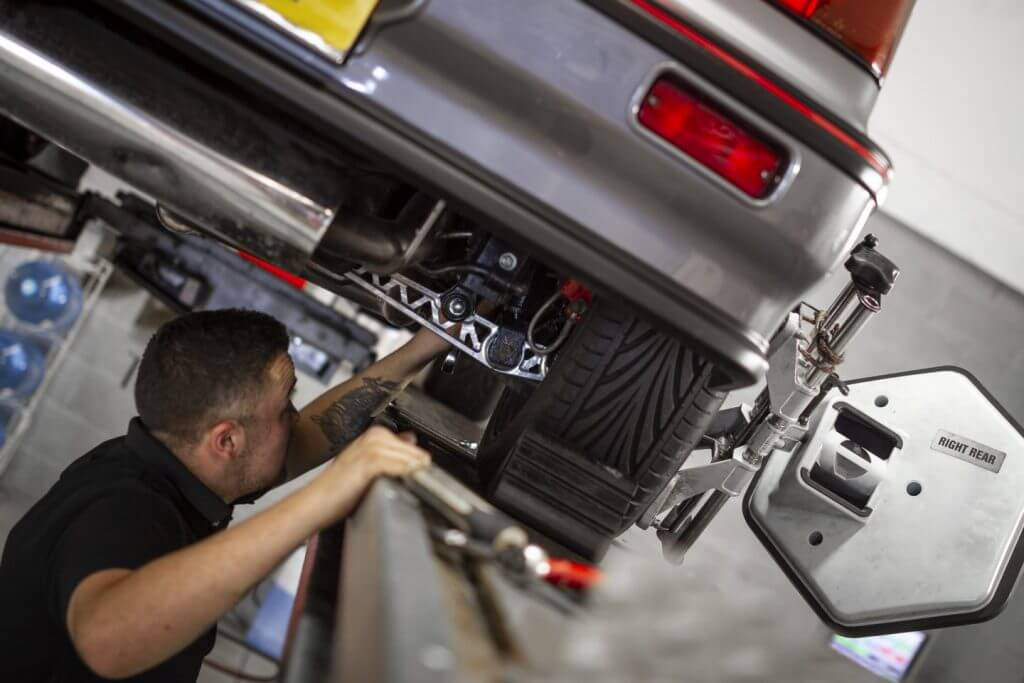
Vehicle manufacturers spend an awful lot of time and money making sure that their new cars handle well and give a good ride. And then what do you do? You drive over potholes, kerbs and rough tarmac (certainly in Britain at least!) – all of which play a part in throwing your car’s wheel alignment out of whack. Not only this, but if you’ve fitted new suspension, wheels, or even just a fresh set of tyres, then your car has almost certainly lost the precisely tuned angles that it left the factory with. This can foul up your handling, increase your fuel consumption, and make your expensive tyres wear much faster than they should. But don’t fret, because all is not lost!
Here at Demon Tweeks, we are able to offer a high-tech four-wheel alignment service using our Hunter alignment rig. This system will precisely measure angles on all four of your car’s wheels – allowing our trained technicians to adjust your suspension accordingly. If you’ve not had this done for a while, or if you’ve fitted new parts to your car’s suspension or wheel setup, we’re confident that you’ll instantly notice the difference from having the vehicle aligned properly. Whilst this isn’t perhaps the most glamorous thing to have done to your car, in the real world, it is one of the most useful. It’s also not to be confused with tracking which refers to one particular measurement that’s carried out during a four-wheel alignment; although you often hear people use the two terms interchangeably.
Aftermarket Alignment Products

Sometimes you might want to change the alignment of your car in order to achieve different things – and although most modern cars allow for a degree of adjustability in this regard, there is a limit to what can be done. You might also find that when you lower your car past a certain point, you need to modify the original suspension fitted to the car to keep your car handling right.
You might also be setting your car up for stance or drift, where a lot of camber is important to handling or looks.
For this reason, a number of aftermarket suspension companies have begun to offer products which will allow you to adjust specific measurements – such as camber or castor angle.
Whilst this is no job for an amateur, it will allow a professional with access to a proper alignment rig (like ours) to adjust your suspension more effectively. To see what is available for your car, check out our range of suspension alignment products.
Performance Tyres
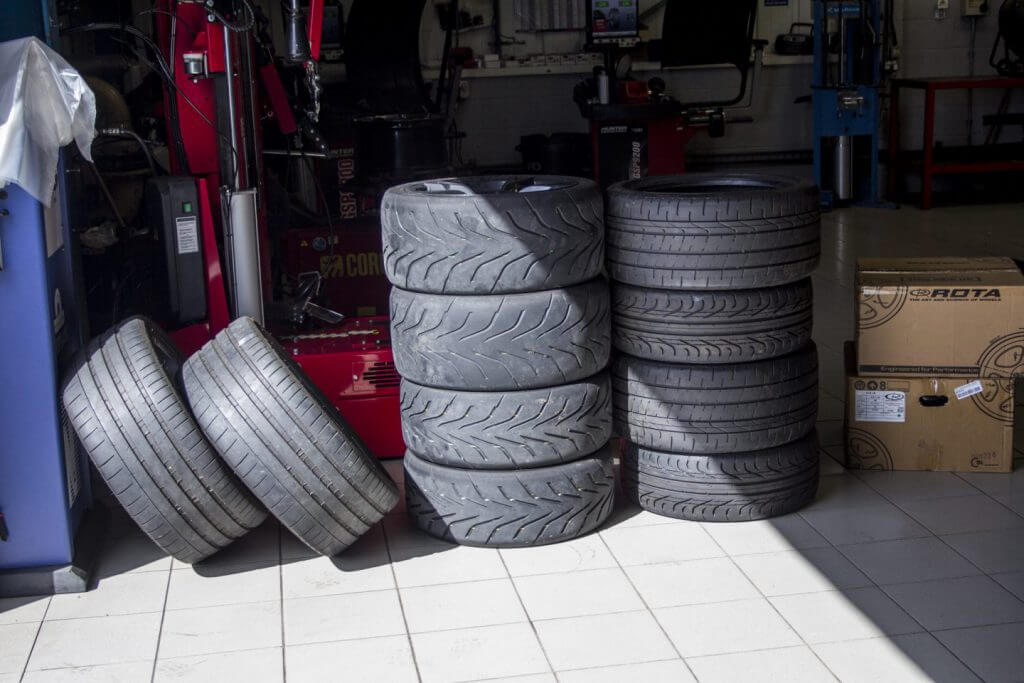
In some ways, tyres are simultaneously the most important and most neglected part of a car. These things are responsible for providing traction for braking, acceleration, going around corners, and even have a role to play in the car’s suspension – absorbing a good deal of impact from any bumps you encounter. We haven’t even touched on the fact that they have to do all of these things whilst being hard-wearing, having a tread that will shed water effectively, and being rolled around on the tarmac! There’s a lot more to your tyres than meets the eye, so it’s really worth fitting the best that you can afford.
The most important thing when it comes to your tyres is actually free and easy to adjust – make sure that your pressures are correct! This should be checked at least once per month, and you should also adjust it if you have an abnormal load in the car. This will ensure that your car handles as it should, and could even give you an early warning of a potential blowout! A portable 12v compressor is perfect for checking your pressures if you can’t be bothered spending that much time queuing on the garage forecourt!
We sell performance tyres from various brands – with bestsellers including Toyo, Yokohama, Michelin, Pirelli, Uniroyal, and more. A performance tyre will use a special compound and tread pattern to make it stick to the road. In winter, a very effective way to increase your car’s stability is to fit a set of winter tyres as when temperatures drop below about 7 degrees Celsius, these things will make a big difference to the way your car drives – just check out the video below if you don’t believe us!
Alloy Wheels


Whilst we’re on the subject of tyres, we should really consider the things they attach to – you know, those round metal things… Wheels don’t typically get as neglected as tyres – being the sexy bits of engineering they are – but you may not have considered them from a performance/handling viewpoint. By switching your factory rims to a larger set, you’ll enable yourself to use wider, lower profile tyres. Not only are ultra-high performance tyres often only available in larger sizes, but fitting lower profile, wider tyres will generally result in better handling. Wider tyres mean more surface area in contact with the road –so more grip in dry conditions – and a lower profile (less height from the rim) is less prone to compression during hard cornering.
In addition to looking good, and letting you fit better tyres, performance rims will often be lighter than standard wheels. This will decrease your car’s ‘unsprung mass’ (the mass of the car which is not attached upwards of the suspension) – which will mean that your suspension has less work to do, and will therefore handle bumpy road surfaces much better. This is in addition to the many other benefits that come from saving weight on your car – including increased acceleration, improved braking, and greater fuel economy. Another effect that lighter wheels will give is to reduce your car’s ‘rotating mass’. Simply put, things effectively weigh more when they are spinning, so losing weight in such an area is very effective. You might not notice a massive difference in this regard, but it’s certainly a bonus when something looks good and improves things on a technical level!
Wheel fitment can be a complicated thing, and it’s very dependent on your particular car and the effect you’re trying to achieve. Luckily we’ve written up a full Alloy Wheel Fitment Guide that explains everything you need to know. If you’re still stuck though, feel free to give our Wheels Tyres and Exhausts Team a shout – as they will probably be able to tell you the answer off the top of their head!
Wheel Spacers


We’ve mentioned your cars centre of gravity when talking about lowering it. You can also lower your cars centre of gravity by making it’s track wider. There’s a reason race-cars tend to be low and wide. The simplest way to make your cars track wider (apart from fitting wider wheels) is to fit wheel spacers.
This is a bit of metal that sits between your cars hubs and the wheel itself. By spacing the tyres out you make your car more stable and less prone to body roll.
If the idea of an extra bit of metal between your wheel and hub gives you pause for thought, you’re quite sensible. All of the wheel spacers we sell are properly designed and machined to fit flush. If you know what you’re doing, we have a range of universal wheel spacers but if you’re less certain, you can buy a set of TUV certified vehicle specific wheel spacers. This will be a kit tested specifically on your make and model, so you can be happy that the wheel spacers will definitely fit your specific vehicle.
Strut and Body Braces
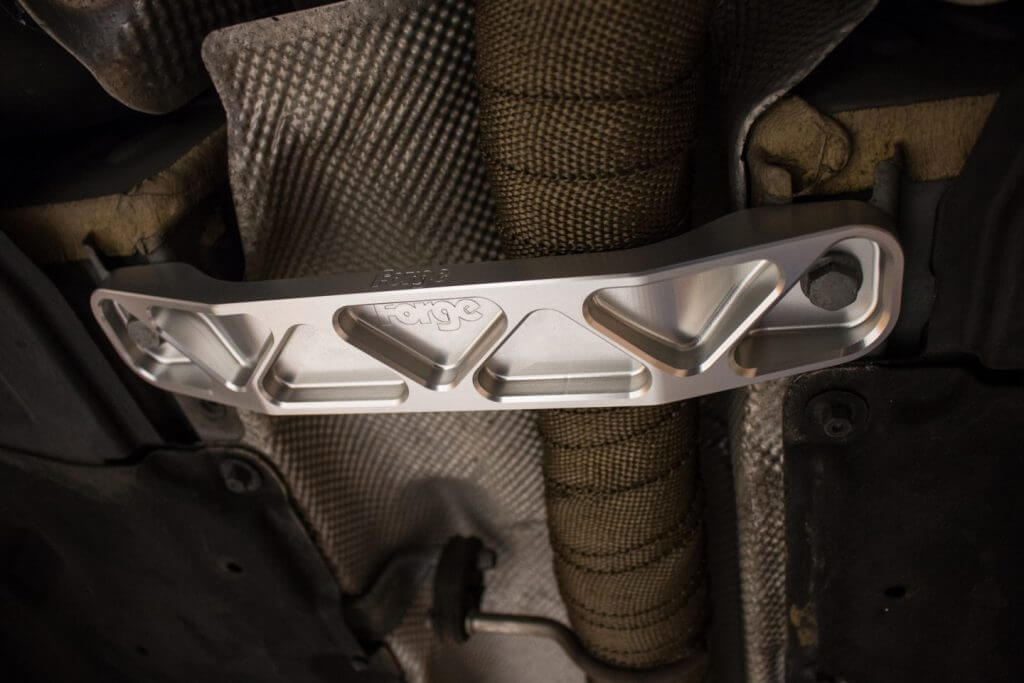
A lot of the mods we’ve covered so far in this post will improve your car’s geometry. But when you’re driving ‘enthusiastically’, there are a lot of forces placed on your car that can flex this geometry. To avoid falling victim to this, it’s important to stiffen your car – and keep it stiff! The simplest way to do this is to bolt on a strut or body brace.
As the name suggests, a strut brace sits between your suspension struts – bracing one against the other to safeguard against flex. Strut braces can either sit at the top end of the struts, or below them – and at the front or rear of the car. Their availability will depend on the design of your car’s suspension – it’s unlikely that you’ll find a rear strut brace for your car if it doesn’t have any rear struts, after all!
Some strut braces will require you to drill into your cars strut tops in order to fit them, but most simply bolt into place using the existing fittings. All in all, this is a simple (and cheap) but effective mod, and will give your car a racier look under the bonnet. Some strut braces will require you to drill into your strut mounts in order to fit, but this depends on the car and many just bolt into place.
Depending on your car there may also be other underbody braces available. These typically go between bits of your cars chassis and stiffen things up.
Roll cage and weight reduction
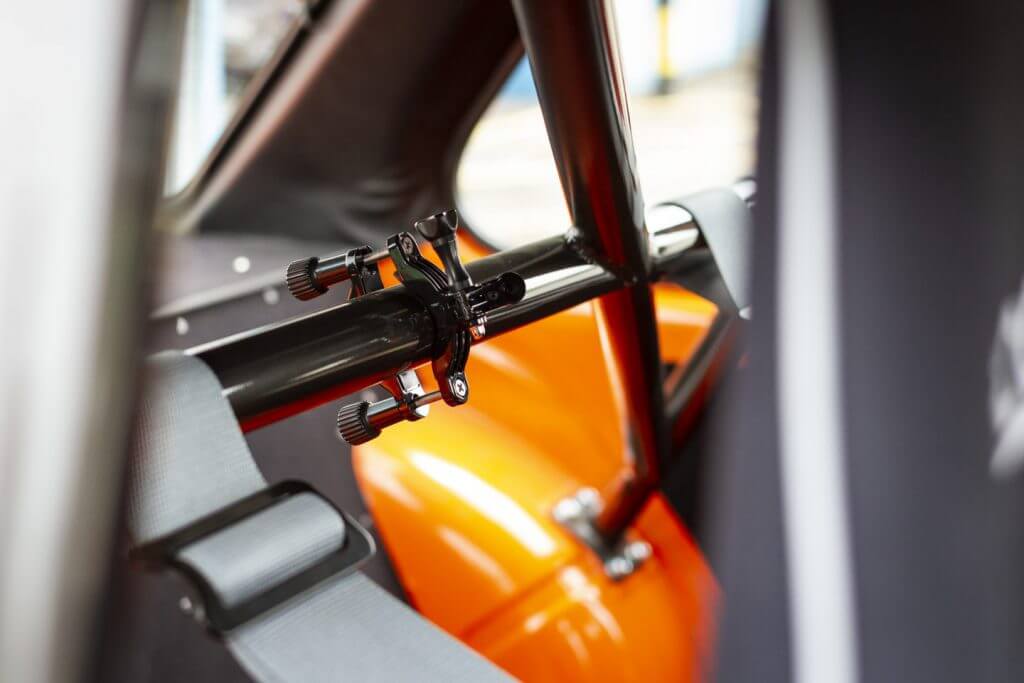

If you think that bolting steel tubes in between your suspension struts is a bit extreme, then you should probably skip this next section. Taking things to the nth degree, if you really want to stiffen up your chassis, then the best way to do it is by fitting a roll cage. These come in two main flavours – bolt in and weld in – with the welded type being preferable (and also permanent). A roll cage will also help to protect you, should you have any unforeseen spills (just do a YouTube search for ‘rally crash’ if you have any doubts about how well they work!).
Generally, if you fit a roll cage then you’ll also be removing at least some of your car’s interior. This will make the car a lot louder, and if you’re going to use the car every day on the road, DT’s Rich (who has personal experience of this) recommends earplugs! Removing the interior will lower the weight of the car fairly dramatically (depending on how far you go) – and this will probably make your braking, acceleration and handling improve quite a lot. As we say though, you’ll have to be fairly dedicated to live with it every day – especially if you have a loud exhaust! Having thick steel tubing right next to your head isn’t ideal when you’re not wearing a helmet, so you’ll probably want to fit some roll bar padding – and you might want to consider a pair of race seats coupled with a set of race harnesses to keep you from moving about too much and whacking your head!
Poly bushes


We’re not talking about the type of bush that you find in your garden, and we’re definitely not talking about the other kind (because we’re not like that). Suspension bushes (as pictured above), are used to join a variety of components together under your car. As standard, bushes/bushings are generally made of rubber – which provides a bit of cushioning, whilst being cheap to produce. This is brilliant on your nan’s Micra, but not so great if you’re interested in your car’s handling.
A much better choice of material for performance bushes is polyurethane. Poly bushes don’t compress as much as rubber ones – meaning that suspension components will move about much less when under stress – keeping your car’s geometry in line. This obviously means that the car’s ride will be firmer, and poly bushes can be a little crashy/creaky over speed bumps, but the other trade off here is that they last almost forever. This is in contrast to rubber bushes, which can wear out quite regularly on some cars. Popular firms like Powerflex are so confident in their poly bushes that they actually come with a lifetime warranty. Whilst bushes themselves aren’t that expensive, they’re generally fitted in fairly annoying locations under your chassis, and can need ‘persuasion’ to fit, so they generally end up costing a bit to replace. Polyurethane is therefore a popular choice when it comes to bush replacement time – because that way you only pay once.
Anti-roll bars
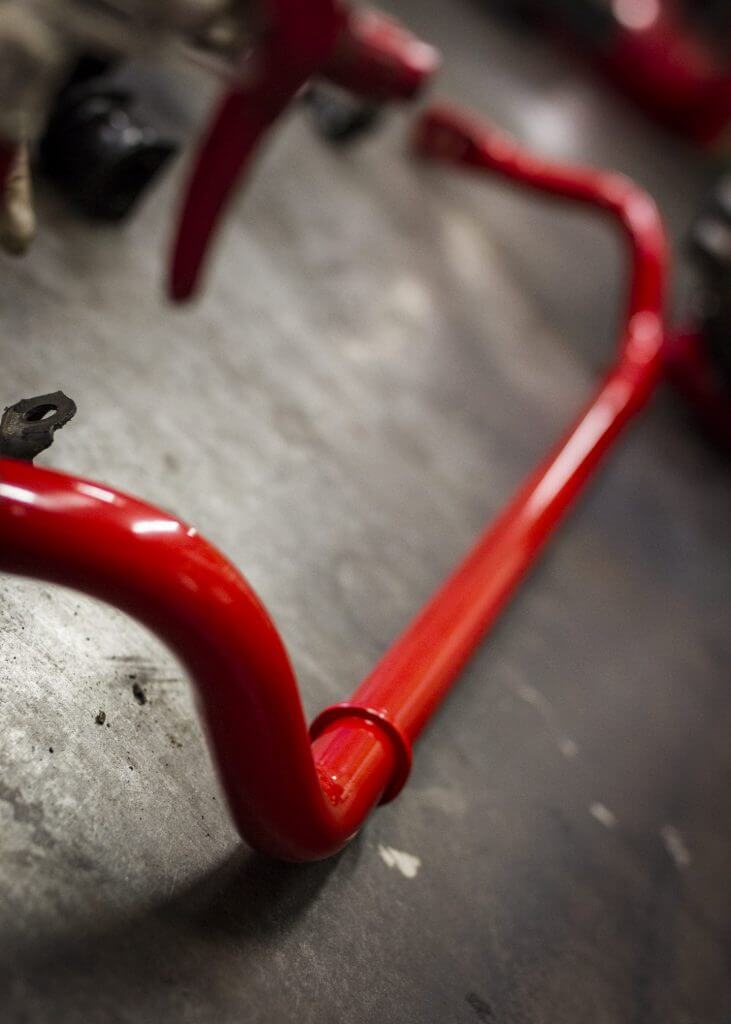

Anti-roll bars – the name is fairly self-explanatory really. The way they work though…? Not so much! Well actually it’s fairly simple. Not to be confused with strut braces (see above), anti-roll bars reduce body roll during hard cornering by taking some of the forces generated on one side of your suspension and transferring them to the other. This helps the vehicle to lean less during cornering – improving traction and meaning that you can go faster around bends.
On a FWD (front wheel drive) car, as standard you’ll probably have a stiff anti-roll bar at the front and a weaker setup at the rear. Upgrading the rear anti-roll bar to something stiffer is generally a good idea in this situation. RWD (rear wheel drive) cars are generally the reverse in terms of anti-roll bars when they come from the factory. Here, the best way to improve things is generally to fit a stiffer front anti-roll bar. 4×4 cars can vary in terms of anti-roll bar setup – often depending on the style of 4×4 system fitted. Take care whenever you adjust your anti-roll bar setup – as you can introduce unwanted understeer or oversteer, which could be dangerous if you’re not expecting it. Firms like Whiteline, Eibach, and H&R are now producing anti-roll bar kits for a variety of performance road cars which are pre-set and require no adjusting. Anti-roll bars can be quite easy to fit on some cars, but on others it’s an absolute pig of a job. With this in mind, we rated this as a full five spanners!
Want more?
Although we’ve covered some of the main bolt-on methods for improving handling here, there are many more means available. One way that you can massively improve your car’s performance whilst making it safer and sexier is to fit some uprated brakes – watch this space for a full guide on these. High-speed stability can be improved by modifying your car’s aerodynamics – and again, watch this space for more info on this. If you don’t mind having some gearbox work done, you could even go as far as fitting a limited slip differential – which will aid your handling and can also provide a lot more straight-line traction on higher-powered cars. One thing’s for certain – whatever you decide to go for, we probably sell it!

Great advice – people overlook handling and wheel alignment when getting the little tweaks can make such a difference to the drive.
great article very helpful
Cheers – glad you found it helpful!
I’m new to cars and tuning,(ex biker you see) I’ve recently purchased a golf mk 4 V5 so was made up when I found your page; Its straightforward and easily understood which is essential for a tuning novice like myself, so thanks a lot 😀 I look forward to reading the info regarding aerodynamics and breaks, so PLEASE HURRY UP AND POST IT!! lol 😛
Hi Paul, glad you’re enjoying the blog and finding it useful! Sounds like we’d better get a move on writing guides!
i am new with the modify and love the articles. Have found them very helpful. I have recently purchased my first car, a zs 180 and already gone for the spings and strut brace. Thank for the tips
Thanks for the tip that getting better rim will help my car have better handling. I’m interested in getting some performance tuning done for my car this months because I’d like to maximize its speed. I think that interstate travel would be significantly be faster even with just the slightest optimization done to my car.